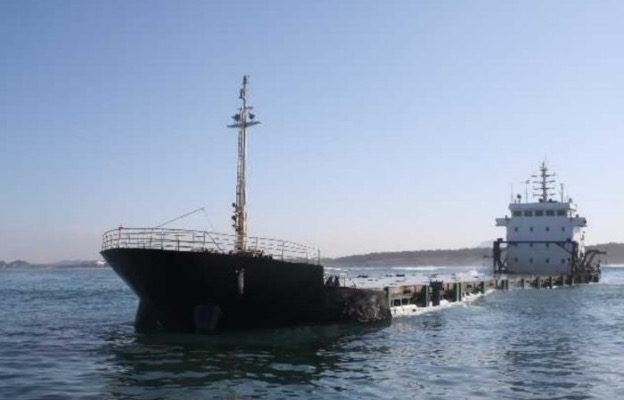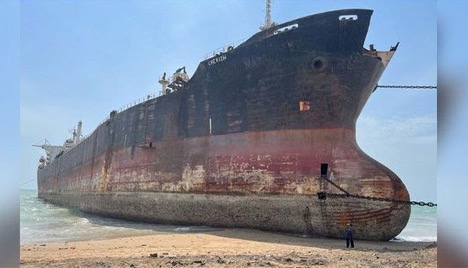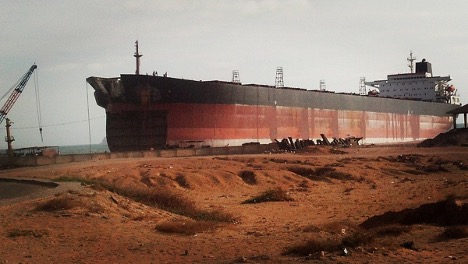One of the many tough decisions sometimes required to be taken by shipmasters is deliberately grounding a ship, an act referred to as “beaching”. It is a tough decision because a shipmaster at that time, for safety or commercial reasons, has to take the decision to beach a ship – run his ship aground, an act that he has been trained throughout his career to prevent.
Beaching of a ship is the process of intentionally grounding a vessel at a suitable location for repair, maintenance, or other work to be carried out on it.

There are several reasons why beaching a ship might be necessary or desirable. In this write-up, we shall take a look at the various reasons why ships are beached, the beaching procedures, and issues connected with the beaching of ships.
Why Do Ships Beach?
Ships beach for a variety of reasons, including bad weather, mechanical problems, and even deliberate actions by the crew. In some cases, beaching a ship can be the best option to avoid a more serious disaster. For example, if a ship is in danger of sinking, beaching it can be a way to prevent it from going down with all hands lost.
Of course, beaching a ship is not without its risks. The ship can be damaged by the waves and it can be difficult to get it off the beach once it’s stranded. But in some cases, beaching a ship is the best option available.
Beaching is usually the result of a captain intentionally running aground to prevent his ship from sinking or being dashed to pieces on rocks or reefs. Sometimes, beaching is the best option when a ship is leaking badly and the pumps can’t cope with the ingress of water.
To prevent the vessel from foundering the master might decide to beach the ship in order to make repairs. Other times, beaching may be the only way to escape a dangerous situation, such as a storm or collision.
What Are The Advantages Of Beaching A Ship?
Beaching a ship has a number of advantages. First, it allows for easy and safe access to the hull of the ship for inspection and repairs. During an emergency when the vessel is in danger of foundering in deep water, beaching allows for time to do a proper inspection to ascertain the damage and safely carry out required repairs, even temporary in order to continue the voyage.
Second, beaching a ship can provide a measure of protection from bad weather and rough seas. When a ship encounters bad weather and it does not have adequate power to withstand it, firmly putting the vessel aground and taking on ballast to stay firmly aground might prevent the vessel from being blown onto rocks or dangerous shore where it might rather end up as a wreck/
Finally, beaching a ship can help to reduce wear and tear on the hull by preventing it from coming into contact with rocks and other underwater obstacles.
The Disadvantages Of Beaching A Ship
Beaching a ship is a process in which a vessel is intentionally grounded on a beach in order to clean, repair, or refloat it. While beaching a ship can be a useful technique in some situations, it also has a number of disadvantages.
The most obvious disadvantage of beaching a ship is the potential damage that can be done to the vessel. If the ship is not properly supported, the waves can quickly erode the hull, causing the vessel to leak or even sink. Beaching a ship can also cause damage to the propellers and other underwater components.
In addition to the potential damage to the ship, beaching a vessel can also be dangerous for the crew. If the ship is not properly secured, it can roll over, trapping and potentially injuring the crew members.

Beaching a ship is often seen as a quick and easy way to recycle a vessel. However, there are several disadvantages to this method of recycling a ship.
First, beaching can contaminate the surrounding area with oil and other pollutants. Recycling can also cause harm to the workers.
Beaching A Ship: The Process.
Once the decision has been made to beach the ship, a suitable place should be selected. The most suitable would be a sheltered, gently shelving beach comprising sand or gravel with little or no rocks. If such a decision is taken then the following should be considered:
- If time and prevailing circumstances permit take in full ballast so as to make refloating easier.
- Beaching should not be done on the high tide but rather midway between high and low tide on a falling tide. Beaching on a rising tide runs the possibility of being pushed further up the beach when the tide rises.
- Approach the beach at right angles making due allowance for wind and tide.
- Lay out anchors and cables at the proper positions to help prevent the vessel from being turned parallel to the beach.
- Keep enough steerageway on the vessel to prevent drift of the seaward end of the ship
- Once the vessel touches the ground keep engines running a little bit to run the vessel firmly aground.
- Take in extra ballast to ensure the vessel will stay firmly aground to avoid pounding in the surf.
Beaching Ships For Scrap In Turkey.
Ship recycling in Turkey takes place in an industrial zone that is owned by the state but leased out to private businesses. The yards are located in Aliaa, which is situated about fifty kilometers to the north of Izmir along the shore of the Aegean Sea.
This region is home to a significant number of heavy enterprises. There are 22 companies working in the sector which has a workforce of about 1500 workers. The zone was initially formed in 1976 as a result of a regulation issued by the government.
Turkish recycling yards use the Landing method which is used in areas where there is almost no tidal difference. Ships are driven onto the shore, or onto a concrete slipway extending to the sea. The aft of the ship remains afloat, whilst the front of the ship is brought above drainage systems. Cranes are used to remove cut-off sections of the ship and the vessel is progressively pulled further on the shore, above drainage systems, during the cutting operations.
Although the Turkish recycling industry has received some good reviews on both environmental and social standards, including aligning the legal framework with international environmental conventions there still remain some concerns about workers’ employment conditions, including the accident rate, the management of hazardous wastes downstream, trade union representation and the lack of transparency on occupational diseases.
These perceived “good reviews” however have helped the Turkish ship recycle yards to corner the market lately for cruise ship recycling which has been on the ascendancy after the pandemic despite their offering $250 per tonne as compared to $450 offered by yards in South East Asia.
Beaching Ships For Scrap In Bangladesh
The shipbreaking yards in Bangladesh are situated close outside of Chattogram, which is the country’s most important port city (formerly known as Chittagong). They are comprised of approximately 145 businesses that, during peak periods, have anywhere from 15,000 to 25,000 employees.
The recycling facilities cover a distance of approximately 15 kilometers along the coast in the Sitakund area. According to legend, shipbreaking started in Bangladesh in 1960 when a typhoon drove the Greek vessel MD Alpine aground.

Even though the number of shipbreaking jobs significantly rose during the 1980s, shipbreaking did not become an officially recognized business until 2011, and until then, it was not subject to any regulations.
The shipbreaking industry in Bangladesh has come under fire from several agencies as a result of its unclean and hazardous working conditions. Concerns include working conditions that are deplorable, deadly accidents, the use of child labor, significant degradation of the marine environment, and the dumping of hazardous wastes.
Although there are laws intended to protect both workers and the environment, they are either inadequately enforced because of insufficient enforcement capability or are wilfully ignored as a result of pressure from industry. Often ships at the end of their useful lives are imported under forged certificates that indicate that they do not contain any toxic substances.
As a direct result of this, harmful substances are not appropriately detected and disposed of in a secure manner. According to an estimate provided by the World Bank, Bangladesh will have imported 79.000 tons of asbestos, 240.000 tons of PCBs, and 69.200 tons of poisonous paints that originated from ships that had reached the end of their service lives by the year 2030.
As long as there are no facilities for the storage or treatment of hazardous waste in the Chittagong area, these dangerous substances are either dumped illegally or resold on the secondary market, both of which cause additional harm to the residents in the surrounding area. As someone succinctly puts it: ‘This is the world’s cheapest place to scrap ships – but in Chittagong, it’s people who pay the price”
Conclusion.
While shipmasters are often reluctant to “touch the bottom” with their keels, it appears that there are several instances in emergencies when a properly thought out and executed beaching in an emergency might have probably prevented a catastrophic maritime accident.
- Types of Gas Carriers as per IGC Code – April 22, 2025
- Wind-Assisted Propulsion Systems (WAPS): A Game Changer for Maritime Decarbonization – February 6, 2025
- 10 Boat Salvage Yards in California – January 25, 2025



